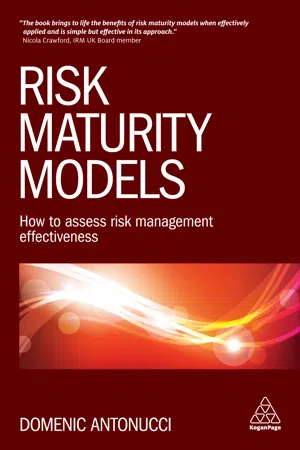
- English
- ePUB (mobile friendly)
- Available on iOS & Android
About This Book
This book offers a practical solution for every organization that needs to monitor the effectiveness of their risk management. Written by a practising Chief Risk Officer, Risk Maturity Models enables you to build confidence in your organization's risk management process through a tailored risk maturity model that lends itself to benchmarking. This is a management tool that is easy to design, practical and powerful, which can baseline and self-improve the maturity capabilities needed to deliver ERM benefits over time. This book guides the reader through comparing and tailoring a wealth of existing models, methods and reference standards and codes (such as ISO 31000 and COSO ERM). Covering 60 risk-related maturity models in clear comparison format, it helps risk professionals to select the approach best suited to their circumstances, and even design their own model. Risk Maturity Models provides focused messages for the risk management function, the internal audit function, and the Board. Combining proven practice and insight with realistic practitioner scenarios, this is essential reading for every risk, project, audit and board professional who wants to move their organization up the risk maturity curve.
Frequently asked questions
03
Comparing risk maturity models against each other
- Dealing with biases
- Approach to comparing models
- Tiering the models
- Directory of 77 models compared
- Results and analysis
- Summary
Introduction
Dealing with biases when comparing risk maturity models
Table of contents
- Cover
- Praise for Risk Maturity Models
- Title Page
- Contents
- List of contributors
- About the author
- Foreword by Kevin Knight
- Foreword by Norman Marks
- Acknowledgements
- List of abbreviations
- Introduction
- 01 Background to risk maturity models
- 02 The case for a risk maturity model
- 03 Comparing risk maturity models against each other
- 04 Tailoring and benchmarking a risk maturity model
- 05 Designing a tailored risk maturity model
- 06 How risk, audit and board functions benefit from risk maturity
- 07 Summary of risk maturity models from practitioner perspectives
- Glossary
- References
- Further reading
- Index
- Copyright